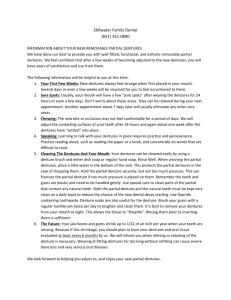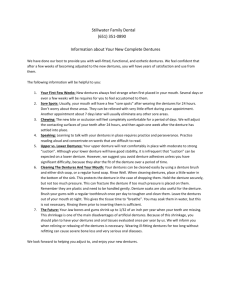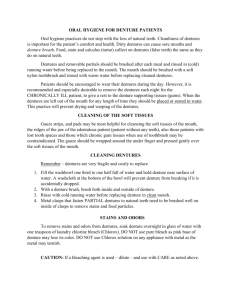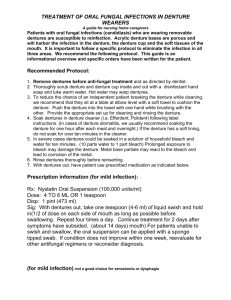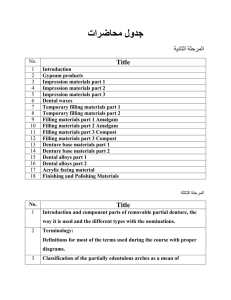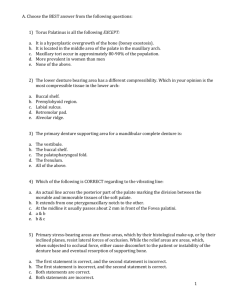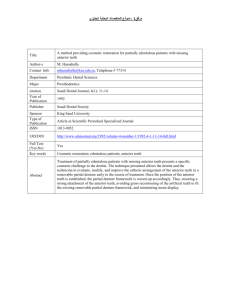Denture Base Resins Part 1
advertisement
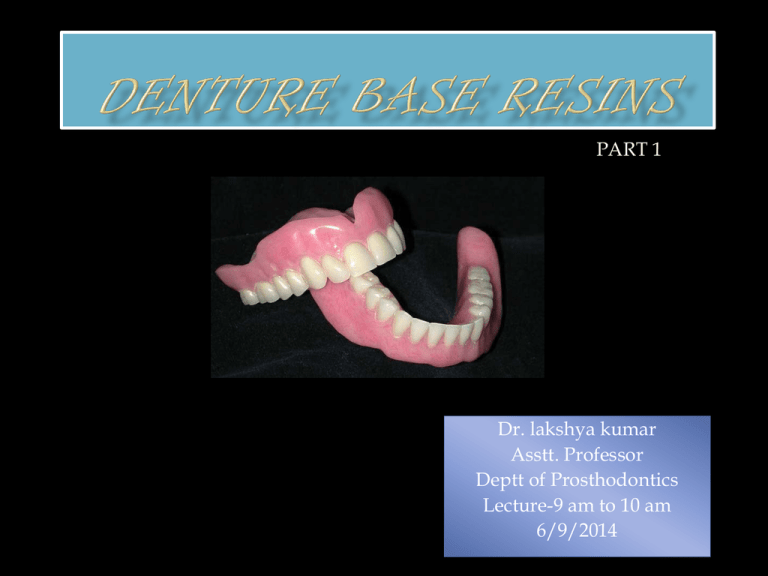
PART 1 Dr. lakshya kumar Asstt. Professor Deptt of Prosthodontics Lecture-9 am to 10 am 6/9/2014 At the end of this Topic Define denture base, denture base material and denture. Classify of denture base materials. Enumerate ideal requirements of denture base materials. Enumerate stages in addition polymerization. Manipulate denture base resin. Denture base: the part of a denture that rests on the foundation tissues and to which teeth are attached Denture base material: any substance of which a denture base may be made Denture: an artificial substitute for missing natural teeth and adjacent tissues All through the history of the making of dentures,we find a constant struggle of the dentist to find a suitable denture base material. Denture base materials Metallic Alloys Denture base resins Denture should be Comfort esthetics FUNCTION 1. Physiologic compatability Nontoxic, Noncarcinogenic , Nonallergenic 2. Acceptability to patients' senses Acceptable to all five senses-sight, sound, smell, taste, and touch Color stable, Odorless, Tasteless Light weight 3. Cost factors Inexpensive equipment for processing Moderate cost of fabrication Good shelf life 4. Functional usefulness Rigid enough so that teeth penetrate the bolus ( food) No interference with oral functions of chewing, swallowing, self cleansing, singing, speech, sneezing, breathing, laughing, coughing, etc. 5. Hygienic factors Sterilizable Nonporous to microorganisms Low fluid absorption Easily cleaned 6. Durability Not affected by oral environment-bacteria, food, medicines, etc. Unbreakable (not brittle) Dimensionally stable Good bond between base and teeth Resistant to weak acids and alkalies Resistant to abrasion and wear TECHNIQUE Clinical steps laboratory steps TEETH ARRANGEMENT PROCESSING ( acrylization ) Skillfully designed dentures were made as early as 700 BC.and Talmud a collection of books of hebrews in 352-407 AD mentioned that teeth were made of gold ,silver,and wood. Egypt was the medical center of ancient world, the first dental prosthesis is believed to have been constructed in egypt about 2500 BC. Hesi-Re Egyptian dentist of about 3000 BC Front and back views of mandibular fixed bridge, four natural incisor teeth and two carved ivory teeth Bound With gold wire found in Sidon-ancient Phoenicia about fifth and fourth century BC. During medieval times dentures were seldom considered ,when installed they were hand carved and and tied in place with silk threads. Those wearing full denture had to remove them before eating. Upper and lower teeth fit poorly and were held together by steel springs. Persian dentist of late eighteen century Indian surgeon of mid nineteenth century WOOD For years, dentures were fashioned from wood . Wood was chosen -readily available -relatively inexpensive -can be carved to desired shape Disadvantages -warped and cracked in moisture -esthetic and hygienic challenges -degradation in oral environment Wooden denture believed to be carved out of box wood in 1538 by Nakoka Tei a Buddist priestess Wooden dentures Bone Bone was chosen due to its availability, reasonable cost and carvability . It is reported that Fauchard fabricated dentures by measuring individual arches with a compass and cutting bone to fit the arches . It had better dimensional stability than wood, esthetic and hygienic concerns remained. IVORY Denture bases and prosthetic teeth were fashioned by carving this material to desired shape Ivory was not available readily and was relatively expensive. Denture bases fashioned from ivory were relatively stable in the oral environment They offered esthetic and hygienic advantage in comparison with denture bases carved from wood or bone. Carved ivory upper denture retained in the mouth by springs with natural human teeth cut off at the Neck and riveted at the base. Since ancient times the most common material for false teeth were animal bone or ivory,especially from elephants or hippopotomus. Human teeth were also used,pulled from the deceased or sold by poor people from their own mouths. Waterloo dentures 1788 A.D. Improvement and development of porcelain dentures by DeChemant. G.Fonzi an italian dentist in Paris invented the Porcelain teeth that revolutionized the construction Of dentures.Picture shows partial denture of about 1830,porcelain teeth of fonzi’s design have been Soldered to a gold backing. CERAMICS Porcelain denture bases were relatively expensive During subsequent years secrets of porcelain denture became known and it became common and inexpensive. ADVANTAGES over wood, bone , ivory were -Could be shaped using additive technique rather than subtractive (carving). -Additive technique facilitated correction of denture base surface. -this permitted more intimate contact with underlying soft tissues. -Could be tinted to simulate the colors of teeth and oral soft tissues. -stable in oral environment. -Minimal water sorption, porosity, and solubility. -Smooth surface provided hygienic properties. Among the drawbacks BRITTLENESS was most significant, fractures were common, often irreparable. One piece porcelain upper denture crafted by Dr John Scarborough,Lambertville,New Jersey 1868. In 1794 John Greenwood began to swage gold bases for dentures. Made George Washington's dentures. George washington’s last dental prosthesis. The palate was swaged from a sheet of gold and ivory teeth riveted To it.The lower denture consists of a single carved block of ivory. The two dentures were held togther by steel Springs. In 1839 an important development took place CHARLES GOODYEAR discovered VULCANIZATION of natural rubber with sulphur(30%) and was patented by Hancock in england in 1843. NELSON GOODYEAR (brother of charles goodyear) got the patent for vulcanite dentures in 1864. . They proceeded to license dentists who used their material, and charged a royalty for all dentures made. Dentists who would not comply were sued. The Goodyear patents expired in 1881, and the company did not again seek to license dentists or dental products. Vulcanite dentures were very popular until the 1940s, when acrylic denture bases replaced them. A set of vulcanite dentures worn by Gen. John J. (Blackjack) Pershing, commander of the American Expeditionary Forces in France during the First World War Set of complete dentures having palate of swaged Gold and porcelain teeth set in vulcanite. In 1868 John Hyatt, A US Printer, discovered the first plastic molding compound, called celluloid. He made it by dissolving nitrocellulose under pressure In 1909, another promising organic compound was found. This was phenol formaldehyde resin discovered by Dr. Leo Backeland . Celluloid upper denture 1880,celluloid as a Substitute for vulcanite was unsuccessful as It absorbs stains and odors in the mouth, Gradually turns black and was flammable. In 1937 Dr. Walter Wright gave dentistry its very useful resin. It was polymethyl methacrylate which proved to be much satisfactory material tested until now. Dentures made of polymethyl methacrylate METALLIC Cobalt – Chromium Gold Alloys Aluminium Stainless Steel Titanium TEMPORARY Self-cure Acrylic resin Shellac Base Plate Hard Base Plate Wax NON-METALLIC Acrylic Resin Vinyl Resin PERMANENT Heat-cure Acrylic resin METALLIC 1. Vulcanite : In 1839 Vulcanized rubber was discovered and introduced as a Vulcanite and Ebonite. For the next 75 years Vulcanite rubber was the principal Denture base Material. But failed because of following reasons : Disadvantages It absorbs Saliva and becomes unhygienic due to bacterial proliferation. Esthetics were poor. Dimensionally unstable. Objectionable taste and odor 2. Celluloid Although it was having tissue like color but having principal disadvantages like Disadvantages Lack of stability Unpleasant taste Unpleasant odor Stainability Flammable 3. Bakelite It was formed by heating and compressing a mixture of phenol and formaldehyde. Disadvantages Lack of uniform quality Variable strength Variable color Dimensional unstability. Chronology of events Charles Goodyear discovery of vulcanized rubber in 1839. John hyatt discovered celluloid in 1868 Dr Leo Bakeland discovered phenol-formaldehyde resin (Bakelite). In the 1930’s Dr Walter Wright and the Vernon brothers working at the Rohn and Haas company in Philadelphia developed Polymethylmethacrylate (PMMA), a hard plastic. Although other materials were used for dental prosthesis, none could come close to PMMA and by the 1940;s 95% of all dentures were made from this acrylic polymer. Dimer - Polymer from two different mers Terpolymer - Polymer from three different mers CH3 CH2 C CH3 CH2 C C O C O O O CH3 C2H5 Methyl Ethyl m METHYL-, ETHYL-, BUTYLMETHACRYLATE COPOLYMER (TERPOLYMER) CH3 CH2 C CH3 CH2 C CH3 CH2 C C O C O C O O O O CH3 C2H5 C4H9 Methyl Ethyl Butyl m Linear Branched Cross-linked Homopolymer Copolymer (random) Copolymer (block) Homopolymer Copolymer (random) PLASTICIZER (dibutyl phthalate) O C O C4H9 C O C4H9 O DEFINITION: A polymer is a long chain organic molecule .It is produced by the reaction of many smaller molecules called monomers,or mers. Resin : A broad term used to describe natural or synthetic substances that form plastic materials after polymerization (GPT-7th edition). USES IN DENTISTRY Denture bases and artificial teeth. Denture liners and tissue conditioners. composite restorative and pit and fissure sealent. Impression materials Custom trays for impression Temporary restoratives. Mouth-guards. Maxillofacial prosthesis. Space maintainers. Veneers. Cements and adhesives. CHEMISTRY OF POLYMERIZATION Monomers react to form polymer by a chemical reaction called polymerization. The most common polymerization reaction for polymers used in dentistry is addition polymerization. ADDITION POLYMERIZATION INDUCTION PROPOGATION CHAIN TRANSFER TERMINATION ACTIVATION Free radicals can be generated by activation of radical producing molecule using. Second chemical Heat Visible light Ultraviolet light Energy transfer from another compound that acts as a free radical. Commonly employed initiator is Benzoyl peroxide which is activated rapidly between 50 degree and 100 degree C to release two free radicals per benzoyl peroxide molecule. Second type is chemically activated ,consists of two reactants when mixed undergo reaction eg tertiary amine (the activator) and benzoyl peroxide (the initiator). Third type is light activated .The visible light light cured dental restoratives,camphorquinone and an organic amine (dimethylaminoethylmethacrylate) generate free radicals when irradiated by light in the blue to violet region. Light with a wavelength of about 470nm is needed to trigger this reaction.
